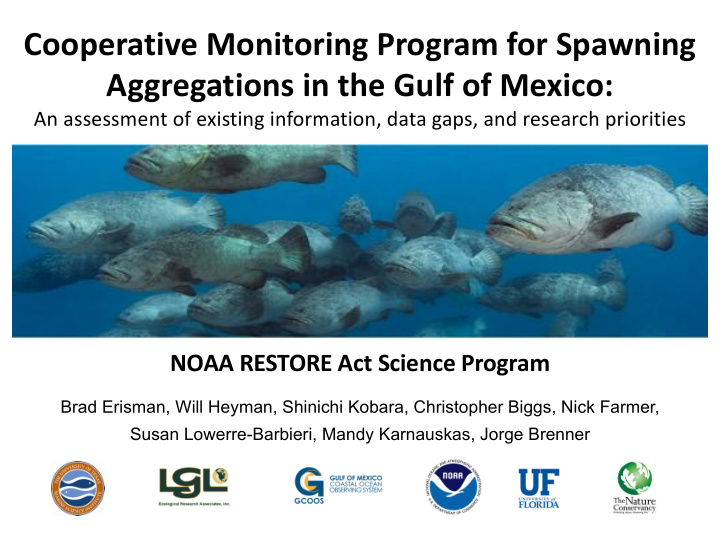



Cooperative Monitoring Program for Spawning Aggregations in the Gulf of Mexico: An assessment of existing information, data gaps, and research priorities NOAA RESTORE Act Science Program Brad Erisman, Will Heyman, Shinichi Kobara, Christopher Biggs, Nick Farmer, Susan Lowerre-Barbieri, Mandy Karnauskas, Jorge Brenner
Fish Spawning Aggregations (FSAs) Temporary, large gatherings of fish that form for the purpose of reproduction, are predictable in time and space, and involve densities higher than non-reproductive periods Critical events for reproductive success • Represent Essential Fish Habitat (EFH) • Important for Ecosystem structure/function • Fish Spawning Aggregations (FSAs) are important to global fisheries... $$$$ Billions Millions Millions
Global Challenge FSAs can be vulnerable to overfishing...fishing effects “scale up” FSAs are declining globally...few are monitored, assessed or managed 500 Inclusion within management works Only 34% of # Aggregation Sites 400 Increased reproductive output • documented sites are Stabilized population structure • 300 managed Practical for monitoring • 200 Improved stock assessments • Increased catches and CPUE • 100 Supports ecosystem-based management • 0 Unknown Decreasing Same Gone Increasing (Erisman et al. 2015, Fish & Fisheries)
Regional Challenge Many species of exploited and protected fishes are known to or likely form FSAs In the Gulf of Mexico ...BUT it is one of the world’s least studied areas for the biology and fisheries of FSAs Despite a wealth of scientific information and regional knowledge on the biology and fisheries on aggregating species
Our Team Support provided by: Scott Hickman (CFA) & Roy Williams Chris Taylor (NOS/NCCOS/CCFHR) Todd Kellison (NOAA SEFSC – Beaufort) John Froeschke (GMFMC) Martin Russell (SCRFA) NOAA Southeast Regional Office Chris Koenig (FSU) Many, many fishermen Objectives 1. Compile and evaluate existing information on fish spawning aggregations in the GOM as the basis to design a cooperative monitoring program for FSAs. 2. Engage in a comprehensive outreach and data-sharing program to ensure all data and project outputs are available to inform management.
Objective #1: Outputs Species Profiles Database of 800 refs. 30 species Spawning Seasons Bathymetric and FSA maps Life history and spawning behavior Species Common Name Jan Feb Mar Apr May Jun Jul Aug Sep Oct Nov Dec Mycteroperca microlepis Gag Epinephelus morio Red Grouper Sciaenops ocellatus Red Drum Lutjanus campechanus Red Snapper Rhomboplites aurorubens Vermilion Snapper Seriola dumerili Greater Amberjack Mycteroperca bonaci Black Grouper Balistes capriscus Gray Triggerfish Lachnolaimus maximus Hogfish Epinephelus striatus Nassau Grouper Hyporthodus flavolimbatus Yellowedge Grouper Hyporthodus niveatus Snowy Grouper Seriola rivoliana Almaco Jack Lutjanus cyanopterus Cubera Snapper Mycteroperca phenax Scamp Epinephelus drummondhayi Speckled Hind Lophola>lus chamaeleon>ceps Tilefish Mycteroperca venenosa Yellowfin Grouper Mycteroperca inters>>alis Yellowmouth Grouper Epinephelus itajara Goliath Grouper Lutjanus analis MuFon Snapper Hyporthodus nigritus Warsaw Grouper Scomberomorus maculatus Spanish Mackerel Scomberomorus cavalla King Mackerel Cynoscion nebulosus SpoFed Seatrout Archosargus probatocephalus Sheepshead Paralichthys lethos>gma Southern Flounder Pogonias cromis Black Drum Monitoring Protocol Vulnerability Assessments Fisheries interac,ons and mgmt. Vulnerability Index
Take-Home Messages 1. Lack of information on locations of spawning aggregations in the Gulf of Mexico. 2. Lack of information on behavioral dynamics of FSAs in space and time (e.g. density change, periodicity, etc.). 3. Commercial fisheries target the spawning season and FSA sites (inferred) of most species. 4. Lack of information on interactions between and impacts of fishing on FSAs. 6. The most vulnerable spp. have not been assessed 5. Transient FSAs are most vulnerable 5. Transient FSAs most vulnerable Vulnerability Index Vulnerability Index
Objective #2: Outputs FSA Workshop gcoos3.tamu.edu/restore October 4-5 2016, NOAA SERO
Research and Management Priorities 1) Mine existing data to assess interaction strengths between fishing and spawning to identify and prioritize areas and species of highest vulnerability 2) Work collaboratively with commercial and recreational fishers to identify, characterize, assess, and monitor key spawning areas 3) Inform and improve stock assessments by incorporating spawning dynamics into existing assessment models 4) Develop management frameworks for FSAs and aggregating species through the Fisheries Management Council process
Next Steps Short-term (1-2 yrs @ $250k/yr) = continue within scope of current project Enhance visibility, access, and capability of website, profiles, databases • • Update GOM bathymetric map (< 200m) and make available on GCOOS/NOAA Continue vulnerability assessment and fishing interaction/impact analyses • Workshops: (1) FSA stock assessments; (2) regional FSA monitoring protocol • Engage recreational fishing sector • • Increase existing collaborations with commercial sector Add more species (bonefish, tarpon, gray snapper, etc.) • Long-term (5-10 yrs @ $1m/yr) Develop a network of fishermen, scientists and managers who cooperatively • predict, characterize, and monitor multi-species FSAs throughout the GOM Develop methods to integrate FSAs into regional stock assessments • Establish long-term monitoring sites for FSAs in the wider GOM • Utilize advanced technologies to improve efficiency & quality of FSA monitoring • Assess the importance of petroleum platforms as suitable FSA sites • Model the potential effects of climate change and fishing pressure on the • phenology, distribution, and productivity of FSAs
Recommend
More recommend